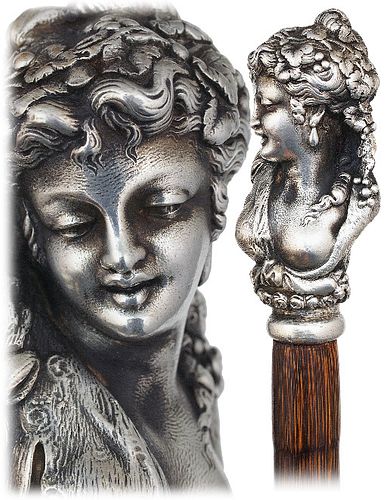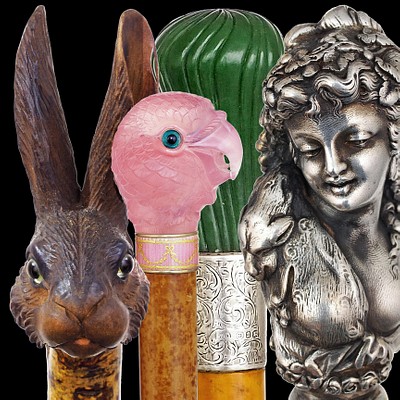Silver Plated Bronze Figural Cane
Lot 22
About Seller
Kimball Sterling
125 West Market Street
Johnson City, TN 37604
United States
Family-owned and family-run Johnson City Tennessee auction business for 25 years. Selling antiques and collectables for 38 years. Kimball M. Sterling, Inc. was founded and is owned by Kimball and Victoria Sterling, time and again, they have laid solid claim to world-wide attention and renown with an...Read more
Categories
About Auction
By Kimball Sterling
Feb 22, 2023 - Mar 12, 2023
Set Reminder
2023-02-22 00:00:00
2023-03-12 00:00:00
America/New_York
Bidsquare
Bidsquare : Passed Cane Auction
https://www.bidsquare.com/auctions/kimball-sterling/passed-cane-auction-12307
Selection of fine canes
Kimball Sterling kimballsterling@earthlink.net- Lot Description
-Ca. 1880 -High-grade figural silver plated bronze handle superbly modeled and hand chased in micro detail to depict the bust of a woman with a lion skin on her shoulders, stepped partridge shaft and a long horn ferrule. Her side wards turned head with superb face and bashful smile exposes a beautifully upswept hair tucked with grapes and wine leaves. A down hanging curl on a bare chest adds an evocative touch and, despite the beauty’s down looking eyes, she engages instantly every viewer in a sensual dialog. The bust ends with a crown of roses that inclines us to believe that it might have been intended as a Bacchante or, more likely, an allegory for the summer. -The style and displayed detail as well as an undeniable freshness are in the celebrated taste of Clodion and warrants further academic research for exact identification. In any case, this easy approachable and eminently desirable cane is French art at its best. -H. 3 ¼” x 1 ½”, O.L. 37” -$700-$900 -Clodion, original name Claude Michel, (born Dec. 20, 1738, Nancy, France—died March 29, 1814, Paris), French sculptor whose works represent the quintessence of the Rococo style. -In 1755 Clodion went to Paris and entered the workshop of Lambert-Sigisbert Adam, his uncle. On his uncle’s death, he became a pupil of J.B. Pigalle. In 1759 he won the grand prize for sculpture at the Académie Royale de Peinture et de Sculpture, and in 1762 he went to Rome. Catherine II was eager for him to come to St. Petersburg, but he returned to Paris in 1771. There he was successful and frequently exhibited at the Salon. -Clodion worked mostly in terracotta, his preferred subject matter being nymphs, satyrs, bacchantes, and other Classical figures sensually portrayed. He was also, with his brothers, a decorator of such objects as candelabra, clocks, and vases. Perhaps because of his apparent unwillingness to be seriously monumental, he was never admitted to the Royal Academy. Nevertheless, after the Revolution had driven him in 1792 to Nancy, where he lived until 1798, he was flexible enough to adapt himself to Neoclassical monumentality—the relief on the Arc de Triomphe du Carrousel, representing the entry of the French into Munich, is an example.
- Shipping Info
-
Each auction has different shipping terms but the buyer always pays.
Canes:
After payment has been received we will contact you.
-
- Buyer's Premium



 EUR
EUR CAD
CAD AUD
AUD GBP
GBP MXN
MXN HKD
HKD CNY
CNY MYR
MYR SEK
SEK SGD
SGD CHF
CHF THB
THB



















